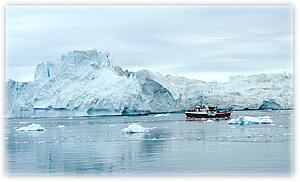Project leader:
Dr. Wilhelm Weinrebe
Tel.: +49 431 600-2281
Fax: +49 431 600-2922
e-mail:wweinrebe(at)geomar.de
Iceflow Activity Revealed From Submarine Morphology - mapping glacial-morphological manifestations of a retreating ice-front
Duration: 01.04.2008-31.03.2010
Funding agency: Excellence Cluster Future Ocean
About 10% of the annual production of Greenland calf ice passes Disko Bay in the northern part of West-Greenland. The amount of 35 km3 of ice annually which is more than any other glacier outside Antarctica produces, floats with a speed of more than 1 m per hour into Disko Bay through Ilulissat Icefjord, a 60 km long and 3-6 km wide tide-water ice-stream. The large calving production and the high velocity imply a rapid response to climate changes. Thus this site is a key area for the understanding of West Greenland Holocene climate history.
The unique and impressive area is a UNESCO World Heritage Site since 2004.

The geology and glaciology of the area was extensively studied for over 250 years. Numerous observations document an advance of the ice-front up to 1851. Since then a constant recession of the glacier front was observed with accelerated speed in recent years. Now the glacier front seems to have reached the same position as during the climatic optimum 4,000 – 5,000 years ago. Consequently, the recession of the glacier front exerts a first-order control on the floating of the icebergs off the front of the ice-stream at the mouth of Ilulissat Icefjord. Large icebergs accumulate over a sill off the fjord mouth where they reside several months until they are finally released through the combined effect of tides and streams, melting, and melt-water lubrication. All these processes shape the morphology of the seafloor in front of the mouth and create characteristic submarine landforms. Revealing the morphology helps to understand these processes. However, in contrast to the well studied surface geology of the area, the bathymetry is incomplete. A first survey was done during the cruise MSM05/3 with RV Merian in June 2007. The results display the extensive shaping of the submarine morphology by glacial processes. Yet, only a small portion of the whole area was covered. The main objective of this project is to achieve a complete image of the submarine morphology of the iceberg stranding and floating area and thus to get information on the extent of iceberg activity, residence times, melting processes and drift away pathways. Through a close cooperation with GEUS, the Geological Survey of Greenland and Denmark, geological sample information will be available to aid in age determination of morphological structures.
The impressive scenery of the icefjord attracts many people, more than one third of all Greenland's visitors come to see this site. Furthermore, as the ongoing climate change is more visible in this sensitive area than anywhere else, in 2007 the Icefjord areas has been visited by several US senators, including the Speaker of the House of Representatives Nancy Pelosi, German Chancellor Angela Merkel, Chairman of the European Commission Manuel Barroso, and Denmarks Prime Minister Anders Fogh Rasmussen. Scientific research in this area will find increased attention. A commitment of the "Future Ocean" Cluster will be recognized worldwide. Through the cooperation with local people the results of our survey will be presented in Greenland using different media and will be visible to locals as well as visitors.

